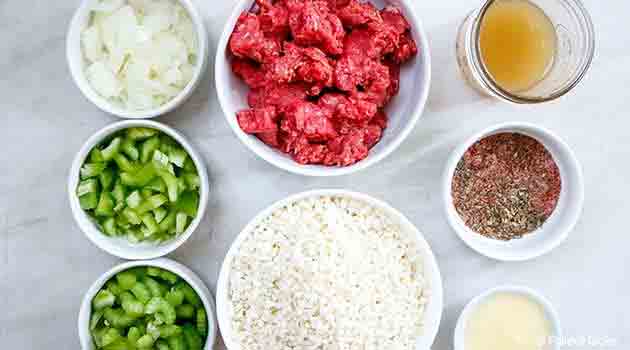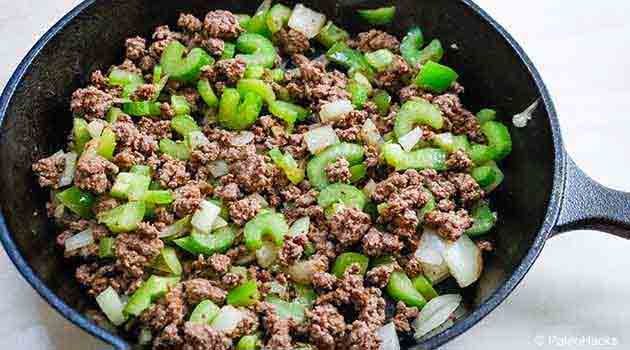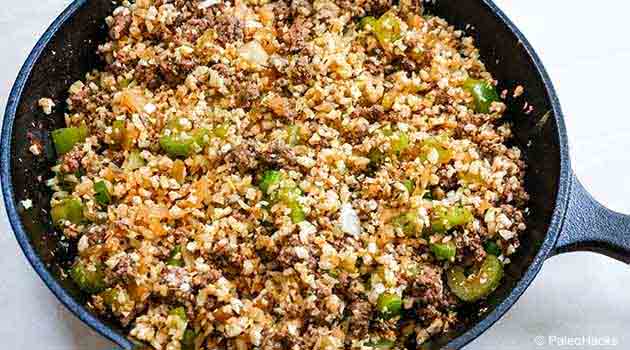You can change your diet and improve your well-being by looking for wholesome and nutrient-filled options that’ll replace lackluster and unhealthy items. One such example is cauliflower rice, which more and more people nowadays are using instead of typical rice varieties. (You make cauliflower rice by pulsing or grating cauliflower until it resembles rice grains or couscous.)
Switching to cauliflower rice provides you with both nutrients and variety — you can combine your favorite vegetables, meats and spices in one dish. This cauliflower rice recipe created for Mercola.com readers by Jennafer Ashley of PaleoHacks is a healthy meal you’ll surely enjoy. Click here to discover more unique ways to cook with cauliflower.

Cajun Cauliflower Dirty Rice Recipe
Prep time: 5 minutes Cook time: 17 minutes Total time: 22 minutes Serving Size: 4
Ingredients
For the Cajun seasoning:
- 1 teaspoon paprika
- 1 teaspoon dried thyme
- 1 teaspoon dried oregano
- 1/2 teaspoon sea salt
- 1/4 teaspoon garlic powder
- 1/4 teaspoon onion powder
- 1/4 teaspoon black pepper
- 1/8 teaspoon cayenne pepper
For the dirty rice:
- 1/2 pound organic grass fed ground beef
- 1 tablespoon ghee
- 1/2 cup green bell pepper, finely chopped
- 1/3 cup sweet white onion, chopped
- 1/2 cup beef stock
- 3 cups cauliflower rice
- 1/2 cup celery
Procedure
|
1Stir together the ingredients for the Cajun seasoning in a small bowl.
|
|
2In a skillet over medium heat, brown ground beef for five minutes. Use a spatula to break up the beef into crumbles.
|
|
3Stir in ghee, chopped bell peppers, onion and celery and continue to cook for seven minutes longer.
|
 |
|
4Add beef stock to the skillet and stir in cauliflower rice and Cajun seasoning. Cook five minutes, stirring occasionally until cauliflower is softened. Serve hot.
|
 |
Add This Mouthwatering Cauliflower Rice Recipe Into Your Arsenal
The use of cauliflower as a healthy rice alternative may have contributed to its increased demand and sales. According to a 2017 Time magazine article, a whopping $390 million worth of cauliflower was sold by U.S. farmers back in 2016, compared to $239 million in 2012.1 However, eating cauliflower rice shouldn’t just be perceived as a health food trend that’ll eventually go away, but rather a conscious diet choice to help improve your overall health and well-being.
What Makes Cauliflower Rice Special?
Did you know that you can eat cauliflower rice either raw or cooked? The Huffington Post explains that the former tends to be crunchy, while the latter is light and fluffy, but tender and chewy too.2 No matter what your preference is, you can be sure that consuming cauliflower may deliver important benefits.
This cruciferous vegetable’s nutrient content is unparalleled, as it contains a wide variety of vitamins (B1, B2, B3, B6, C, K and folate) and minerals (magnesium, phosphorus, potassium and calcium), as well as protein and fiber.3,4
Phytonutrients in cauliflower play a role in this vegetable’s antioxidant abilities. Depending on which color of cauliflower you choose (purple, green and orange varieties are also available), cauliflower contains good quantities of beta-carotene, beta-cryptoxanthin, caffeic acid, cinnamic acid, ferulic acid, quercetin, rutin and kaempferol.5,6,7
A 2012 animal study published in the American Journal of Hypertension noted that sulforaphane, a compound in cauliflower, helped significantly improve blood pressure and kidney function among rats.8 On the other hand, a 2017 Food Function study highlighted that cauliflower leaf powder, when used as a preventive supplement, helped decrease the risk for inflammation and oxidative stress caused by a lipopolysaccharide (LPS) injection in rabbits.9
When buying cauliflower heads, choose those that are clean and creamy white, with bud clusters that are compact and not separated. Avoid cauliflower that’s spotted or dull-colored, or has small flowers in it.10 While most people use white cauliflower for making this dish, as mentioned, you can use purple, green and orange varieties11 for this recipe too.
Wrap cauliflower heads loosely in plastic and store them in your refrigerator. Fresh cauliflower heads may last around two weeks. You may also store fresh cauliflower by cutting them into florets and keeping them inside a sealed plastic bag in the refrigerator. If your refrigerator is well-regulated, the cauliflower may last this way for around one week.
12 To make cauliflower rice, simply pulse it through your food processor or grate using a box grater.
13
Two Tasty Veggies Increase This Dish’s Flavor and Nutrient Content
You can add any of your favorite vegetables to cauliflower rice. For the recipe above, two ingredients not only add color and flavor to this dish, but impart additional benefits too:
- Celery — You may already know that this low-calorie vegetable is abundant in vitamins and minerals, but it’s the other compounds found in celery that steal the show. Flavonoids like beta-carotene and its related components, lutein and zeaxanthin,14 which are present in high amounts, are said to help reduce inflammation and heart disease risk, promote better immune system health, and prevent growth of abnormal cancer-causing cells.
Other antioxidant compounds in celery include flavonols15 (kaempferol and quercertin), natural phenolic dihydrostilbenoids (lunularin) and furanocoumarins16 (bergapten and psoralen). A compound in celery called 3-n-buthylphthalide may also assist in lowering cholesterol and blood pressure levels by promoting relaxation in your blood vessels.17
To buy the best celery, choose those that are crisp and tightly formed in bunches, without brown spots or yellow leaves. Place them inside a plastic bag in the refrigerator for up to two weeks. As much as possible, avoid splitting celery stalks until you’re about to use them. If you notice damaged stalks, discard them and just wash the clean stalks thoroughly.18
- Green bell peppers — Green bell peppers are prized for their powerful vitamin C content that may promote enhanced immune system health, combat harmful free radicals in the body, lower the risk for scurvy and decrease arterial inflammation that may lead to heart disease, diabetes and cholesterol build up.
Green bell peppers are also home to good quantities of antioxidant phytonutrients such as flavonoids, carotenoids, and hydroxycinnamic and hydroxybenzoic acid derivatives.19,20
Purchase green bell peppers that are glossy, firm and feel a bit heavy. Avoid peppers that have soft spots or mold, and feel light to the touch. To store, place them inside paper bags or open-topped plastic bags in your refrigerator. They can be kept for up to two weeks. Make sure to use green bell peppers within 24 hours of cutting them.21
Consuming Grass Fed Beef Delivers Immense Benefits
It has been constantly proven that grass fed beef is superior compared to meat obtained from concentrated animal feeding operations (CAFOs) in terms of quality and nutrient content.22 Grass fed beef is abundant in beta-carotene, omega-3 fatty acids, conjugated linoleic acid, vaccenic acid, and other vitamins and minerals.
More recent research has shown, however, that a particular saturated fat in grass fed beef called stearic acid may promote cardiovascular benefits. According to an August 2018 Nature Communications study, stearic acid intake assisted with lowering the risk for cardiovascular disease and cancer compared to other saturated fats found in animals and plants.23
Grass fed beef is considered a good stearic acid source, with research showing that this type of beef contains 36 percent higher amounts of saturated stearic acid (17.45 percent) compared to grain-fed beef (12.8 percent).24 As much as possible, source your grass fed beef directly from a trustworthy farmer in your area. If you don’t have access to a farmer, purchase meat from supermarkets that carry the American Grassfed Association (AGA) logo. When you see this, you can ensure that the animal was:25
- Fed a diet of 100 percent forage during their lifetime
- Raised on pasture, and not in confined environments
- Not administered any hormones or antibiotics
- Born and raised on American family farms26
This grass fed standard not only provides higher-quality and more nutrient-rich meats, but enables transparency between farmers and consumers, and promotes more humane and sustainable farming practices that even small farmers may deem feasible and achievable.27
About PaleoHacks
PaleoHacks is a top source for amazing Paleo recipes, fitness tips and wellness advice to help you live life to the fullest. If you have questions regarding the Paleo diet in general, PaleoHacks may provide you with the answers that you may need.
+ Sources and References